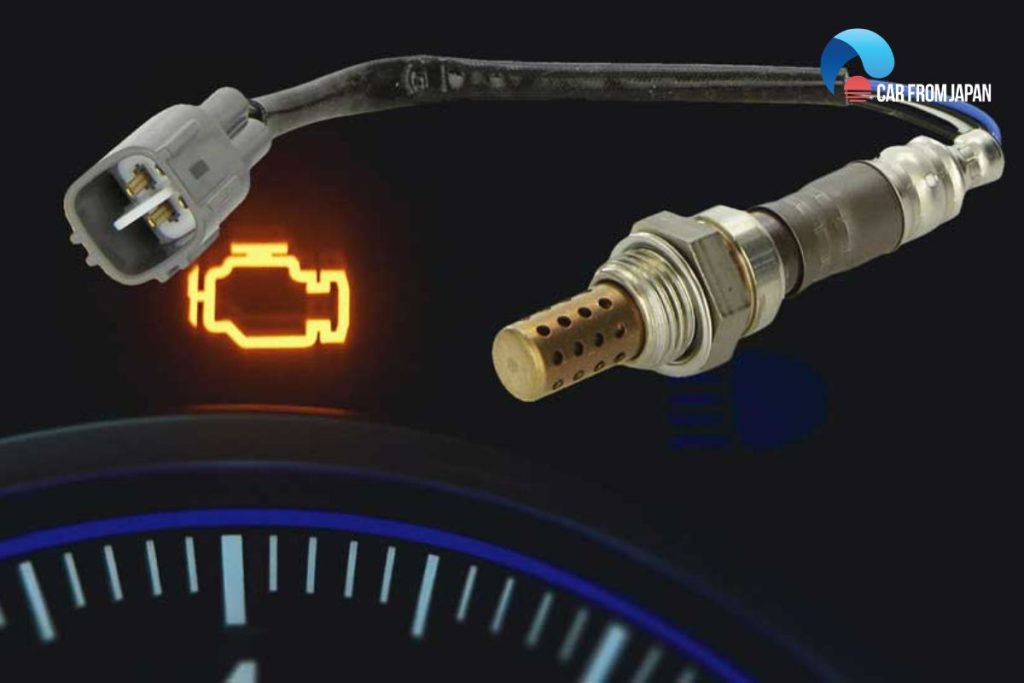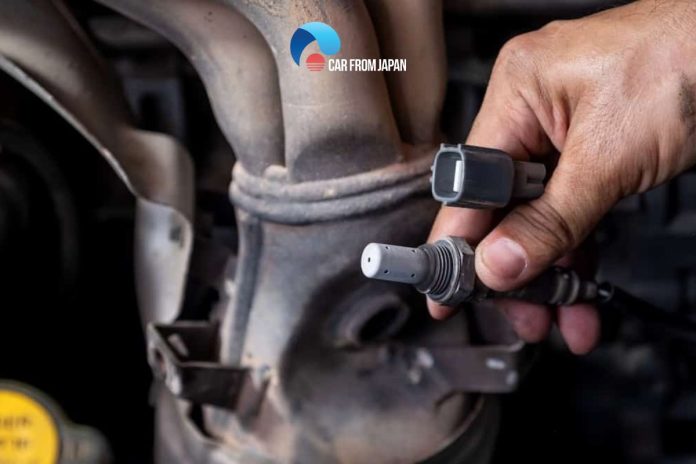Cars showing signs of jerking when accelerating is one of the signs that drivers need to clean the oxygen sensor. We can completely clean the oxygen sensor at home with extremely simple steps.
Let’s deep down to find out how to clean O2 sensor with Car From Japan!
Contents
Something You Need To Know About O2 Sensors
An oxygen sensor is also known as an emissions sensor. This is one of the most important sensors on a car’s engine system. The main function of the oxygen sensor helps to measure the residual oxygen concentration in the car’s exhaust gas.
Then this data is sent to the car ECU so that the engine can adjust the level of fuel filler accordingly, which helps to ensure performance while still complying with emission regulations for vehicles.
Where are oxygen sensors located?
An oxygen sensor is usually located in the threaded hole right in front of the engine’s exhaust catalyst. The exhaust catalyst is usually positioned near the end of the exhaust manifold, behind the silencer.
Vehicles with many cylinders will often have many sensors mounted in the branches of the exhaust system. In some models, the manufacturer installs an oxygen sensor at the back of the exhaust kit.
However, the task of this sensor is only to evaluate the exhaust gas treatment ability of the exhaust catalyst.
How does an O2 sensor work?
The oxygen sensor is one of the important parts of the engine system. A faulty sensor will prevent the engine from reaching its optimum power. So how does the oxygen sensor work?

The emission is discharged and passes through the oxygen sensor, the contact between the emission and the sensor probe will cause the sensor to generate an electric current whose voltage is inversely proportional to the oxygen content in the exhaust gas.
If the oxygen content is high or the air mixture is a “lean mixture”, the voltage generated by the oxygen sensor will be around 0.1V. If the oxygen content is low or the air is a “rich mixture”, the voltage generated by the sensor will be around 0.9V.
Based on this potential, the ECU will adjust the opening time of the fuel injectors appropriately so that the intake air mixture has an air/gasoline ratio close to the ideal ratio.
Related Post: Symptoms Of Bad O2 Sensor: How To Know?
What Happens When Oxygen Sensors Fail?
When the oxygen sensor breaks you will see some symptoms.
Consume more fuel
When the data transmitted to the ECU will be incorrect or no signal will be transmitted. At this time, the ECU can only calculate the amount of fuel based on the intake air flow sensor, unable to analyze it accurately because it does not know the amount of oxygen after combustion.
This causes the fact that even though there is less oxygen in the exhaust gas, the amount of fuel injected is still high, causing “excess gas”, causing the car to consume more fuel than usual. This fuel consumption may increase gradually if it is not rectified soon.
Car exhaust smells like gasoline
If the car smells like gasoline, it is likely that the oxygen sensor in your engine is malfunctioning.
Because at this time, too much gasoline is pumped into the combustion chamber, the gasoline is not fully burned, so it is discharged through the exhaust pipe, creating an unpleasant smell.
“Check engine” light is on
The Check Engine light is responsible for notifying when the engine or related parts have an error. Therefore, if you see the Check Engine light on, it is likely that the oxygen sensor is malfunctioning.
Why Do You Need To Clean The Oxygen Sensor?
In order to drive with the best performance, the function of the sensor components on the car needs to be optimally operated.
In particular, the oxygen sensor is an electronic device mounted in the exhaust pipes, in direct contact with the emission from the engine’s combustion chamber.
This sensor will perform the task of measuring the quality of the emission. Then send a signal to the ECU to evaluate and adjust the fuel ratio as well as the amount of air entering the combustion chamber for the most appropriate.
With this role, the oxygen sensor in the car directly affects the vehicle’s performance, avoiding errors such as unstable speed, sluggish acceleration, and fuel consumption,… Besides, it also ensures the standard emissions and does not pollute the environment.
Therefore, drivers need to check the oxygen sensor, recommended 1 to 2 times per year. This will ensure the timely detection of problems with cleaning, repairing, or replacing the oxygen sensor, ensuring stable performance.
Note: Oxygen sensors won’t get dirty unless you have some serious problems like a bad fuel injector, faulty spark plugs, or cracked ignition coils.
Read More: Why Your Car Has Smelly Exhaust Fumes & How To Fix
How To Clean O2 Sensor: 6 Simple Steps

Some drivers wonder that “Can you clean an O2 sensor?” They’re not sure whether cleaning an oxygen sensor and then putting it back can be an effective way when O2 sensors have a problem.
Because there’s a lot of time there’s no point in wasting your time trying to clean this sensor while it needs to be replaced.
With this question, our answer is “When you notice any symptoms of faulty oxygen sensors. We don’t recommend you clean them, replacing them as a set can be a good solution.
Because oxygen sensors are prone to fragile and very sensitive, it can be completely broken if you don’t use a suitable chemical to clean it.
However, when checking O2 sensors, if there is no damage that needs to be replaced, you want to save a little amount of money. Drivers can clean the oxygen sensor to ensure its longevity as well as the functions to be performed smoothly and efficiently.
Step 1: Prepare tools
The tools needed to clean the oxygen sensor include:
- Wrench for disassembling the oxygen sensor.
- WD-40, gasoline, or carburetor cleaners are the solutions to help remove and clean the oxygen sensor effectively.
- Soft brush to remove “stubborn” dirt.
- Soft towel: dry the sensor after cleaning.
- In addition, you should also prepare extra gloves and glasses to avoid getting stuck with gasoline and cleaning solutions.
Step 2. Locate the oxygen sensor
First, you need to take the car to a spacious location with adequate lighting, can jack up the car to make it easier to locate the oxygen sensor. Next, depending on the model and brand, the number and location of oxygen sensors may be different.
So read the user manual to know the exact position of the sensor. Note that it is necessary to disconnect the power before affecting the sensor, to avoid causing unintended damage.
Typically, cars will have at least two oxygen sensors: one located in front of the catalytic converter and the other located behind the catalytic converter.
Step 3. Remove the oxygen sensor
After locating the oxygen sensors, spray WD-40 evenly, and let’s wait for 10-15 minutes. This solution has a lubricating effect, making it easier to disassemble the sensors.
Then use a wrench to gently remove the oxygen sensors from the vehicle carefully so as not to damage other components.
Step 4. Clean the oxygen sensor with specialized cleaners
Using gasoline to clean the oxygen sensor is relatively simple. Drivers just need to put all sensors in a barrel or basin, use plastic or stainless steel material, and then fill it with gasoline.
Cover the lid and soak overnight or at least 8 hours. Gasoline will clean the plaque and dirt on the oxygen sensor.
Step 5. Clean the oxygen sensor with a soft brush
After soaking the oxygen sensor in gasoline. If there are still stains, you can use a soft brush to gently rub to remove long-standing plaque.
Drivers should pay attention to scrubbing gently, ensuring that the dirt is completely removed. And should not use too much force because it may cause damage to the sensor.
Step 6: Dry and reinstall the sensor
After finishing the cleaning process, use a paper towel or soft cloth to dry the oxygen sensor. Next, install the sensor in its original position, using a wrench to tighten the bolts, to avoid loose installation causing problems when the vehicle is operating.
Thus, with only 6 simple steps, drivers can clean the oxygen sensor themselves at home, both to save money and to help their car operate more smoothly.
Check out this video from Ratchets And Wrenches to learn how to clean 02 sensor properly!
FAQs on How To Clean O2 Sensor
Is it safe to clean an O2 sensor with WD-40?
No, WD-40 is not recommended for cleaning O2 sensors. It leaves an oily residue that can interfere with sensor readings.
Instead, use a dedicated O2 sensor-safe cleaner or a non-residue electrical contact cleaner.
Will an ultrasonic cleaner work for cleaning an O2 sensor?
Yes, an ultrasonic cleaner can help remove deposits, especially when used with an appropriate cleaning solution.
However, avoid using aggressive solvents that might damage the sensor’s delicate components.
Should I clean or replace an O2 sensor with over 100,000 miles on it?
At that mileage, an O2 sensor is likely nearing the end of its lifespan. While cleaning might provide a temporary fix, replacing it ensures long-term reliability and better engine performance.
Is using a propane torch a good way to clean an O2 sensor?
Some mechanics use a propane torch to burn off carbon deposits, but this method carries risks. Excessive heat can damage internal sensor components, so it should only be attempted with caution.
How often should an O2 sensor be cleaned?
Most O2 sensors last 60,000–100,000 miles before needing replacement.
If cleaning is necessary, it should be done only when performance issues arise, not as regular maintenance.
Final Words
So here’s how to clean O2 sensor properly and some notices to save you the cost of replacement.
However, it’s not a guaranteed fix, and heavily damaged sensors will still require professional cares.
You should proceed this cleaning methods above with caution, and disconnecting the sensor is generally the safest approach!



